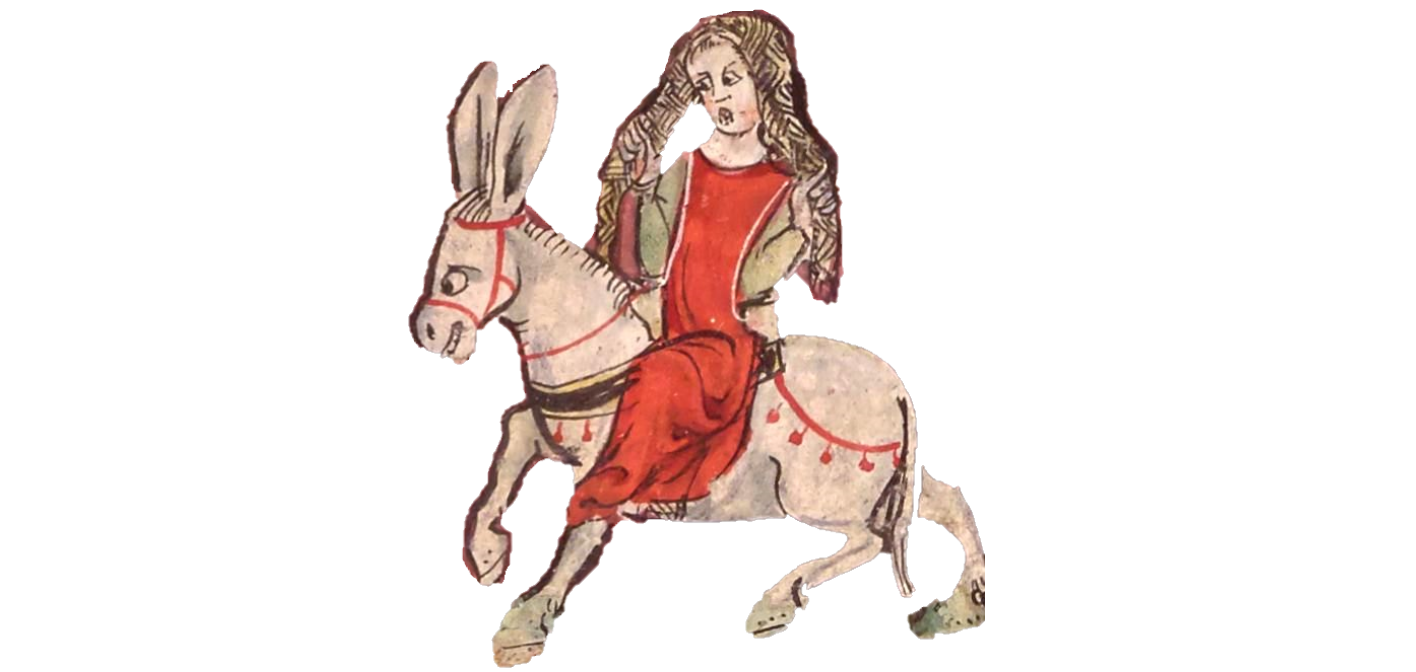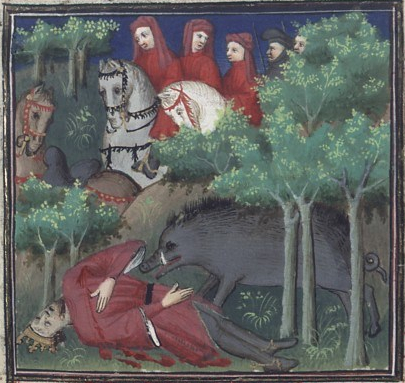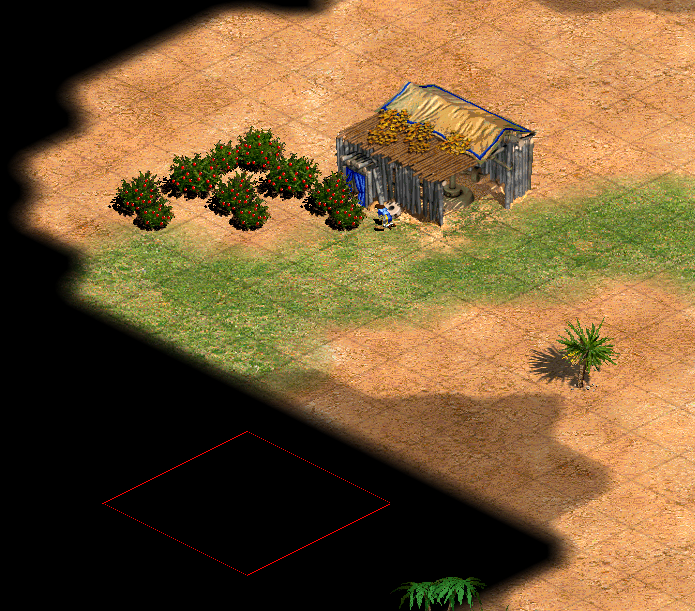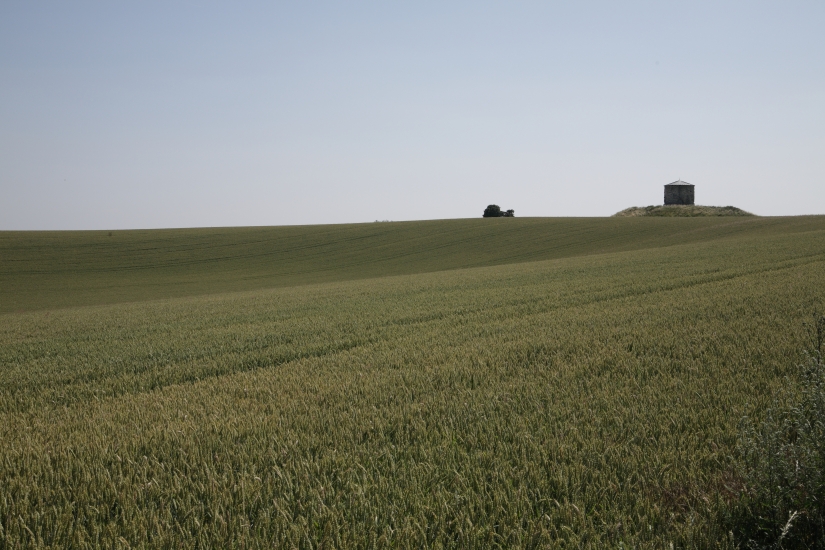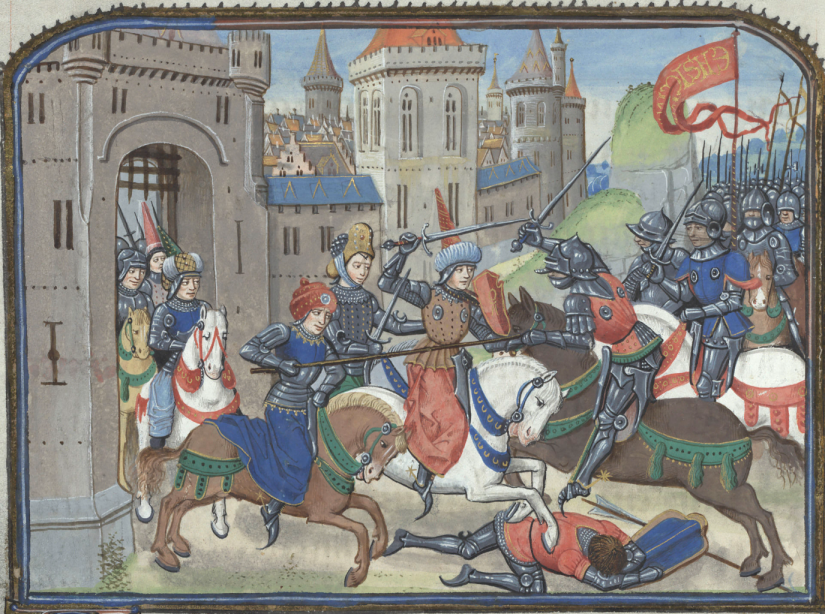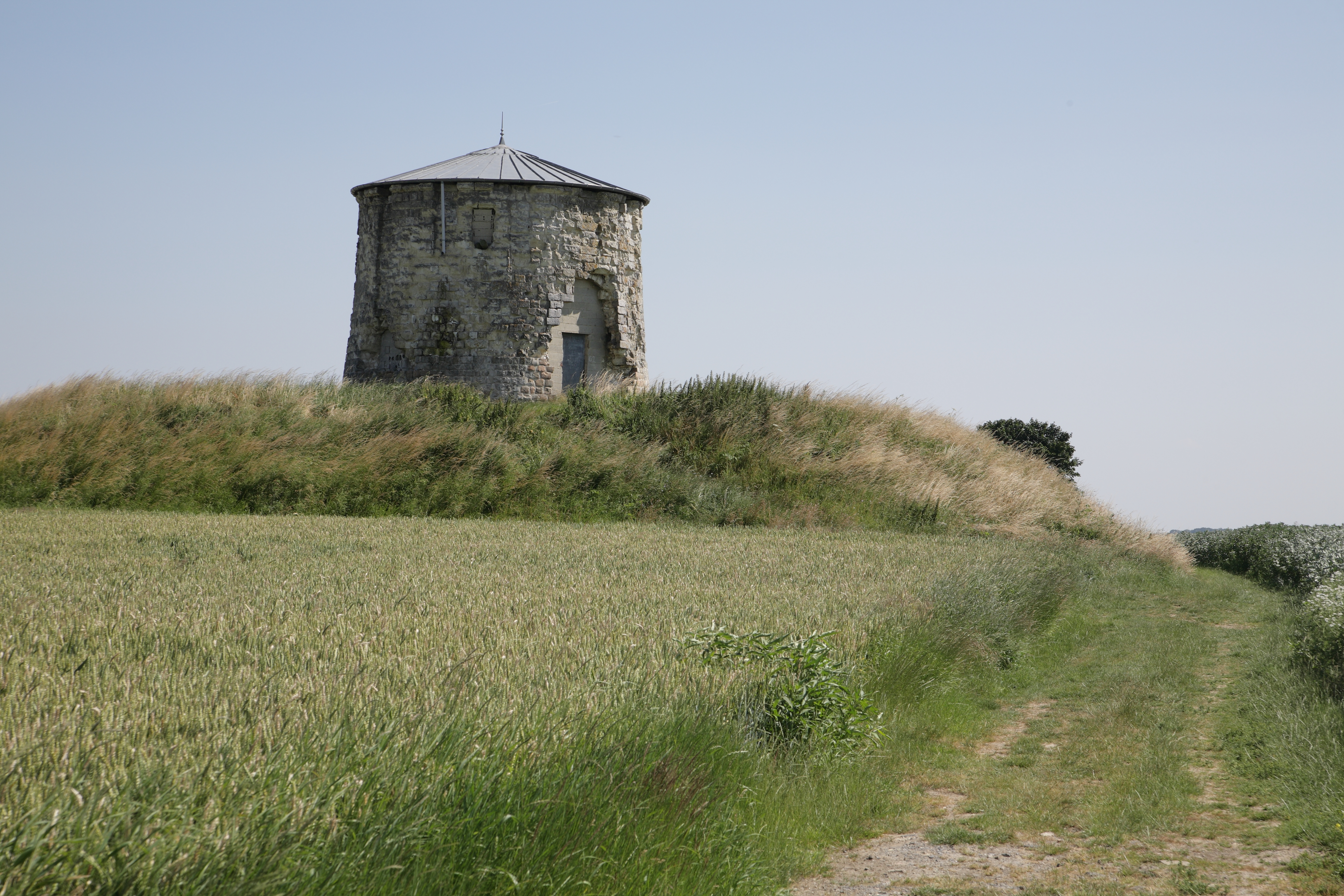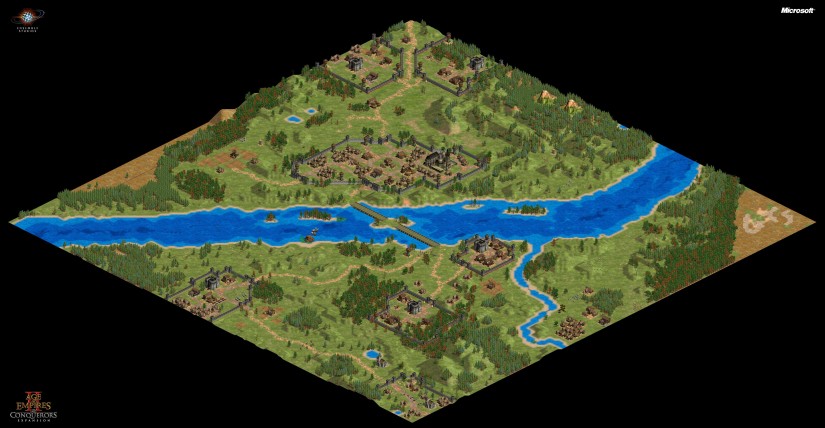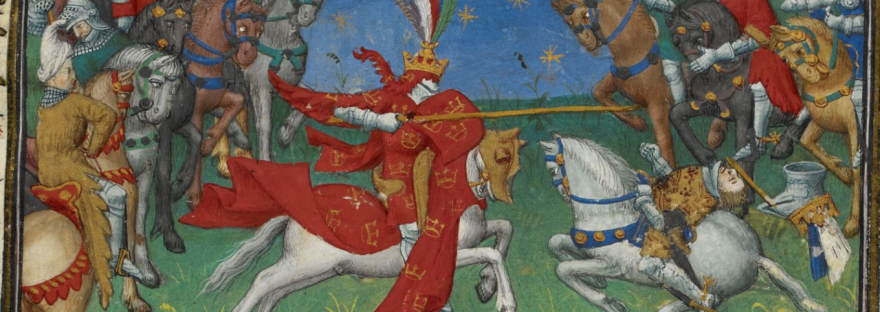I was on Twitter the other day and shared a meme of mine in which Plato talks with the devil. The person whom I sent the meme then asked me what I first constructed as a troll comment: “Why is the devil black?” We find many things on Twitter and I first thought that my interlocutor was leaning toward a slightly veiled racist comment. He kept asking, however, why was the devil pictured as black? That’s when I remembered that the devil is mostly depicted in red today and it hit me that it could be a legitimate question to understand why the devil was pictured as black in medieval manuscripts.
Keep in mind that I’m an ass. As advertized!
The Devil’s Color Today Is Red
I mean, I should have connected the dots faster! I’m Belgian and our national football/soccer team is called the ‘Red Devils’. They’re quite famous nowadays: Eden Hazard (Real Madrid C.F.), Romelu Lukaku (F.C. Internationale Milano), Dries Mertens (S.S.C. Napoli), Axel Witsen (Borussia Dortmund), Vincent Company (formerly at R.S.C. Anderlecht) and Kevin De Bruyne (Manchester City F.C.). All of them are international superstars! When I went to Naples recently, I discovered that talking about the Red Devils was actually a great way to connect with locals (thank you Dries Mertens!).
When I went to Naples recently, I discovered that talking about the Red Devils was actually a great way to connect with locals (thank you Dries Mertens!).
Also, if you look for devils on Google image search, you’ll only see the color red in the matching results. Red is the color of Hell because it is the color of fire and Hell is constructed in our heads as a place full of fire since it is located at the core of the Earth, deep under the surface (whereas angels have white wings since they live above the clouds).
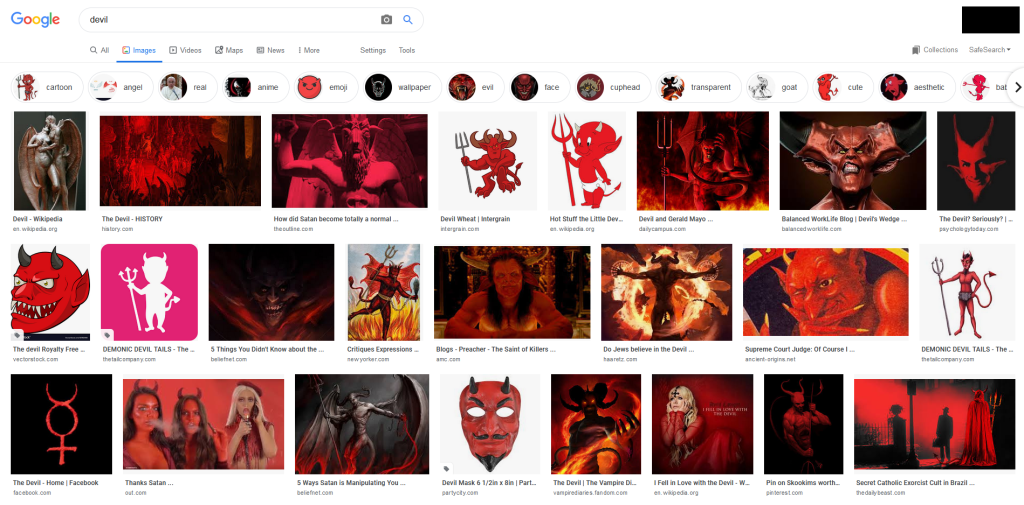
However, red was not always the Devil’s color. I remember watching an old documentary—that I’m too lazy to track down—which told how he was depicted in green a long time ago. Nevertheless the color red caught on a bad reputation in the 16th century among Protestants because it was the color of the people who supported the pope*. Protestants also focused on a passage of the Apocalypse read that red was the color of the beast that rides the whore of Babylon. The color that she also wore herself:
I saw a woman sit upon a scarlet colored beast, full of names of blasphemy, having seven heads and ten horns.
And the woman was arrayed in purple and scarlet color.
~ Book of Revelation, 17:3-4.
Nevertheless the color red caught on a bad reputation in the 16th century among Protestants because it was the color of the people who supported the pope.
As the historian Michel Pastoureau reminds us, Martin Luther saw Rome as the new Babylon. Red was therefore the color to avoid at all cost. It comes as no surprise then that the color red gradually became more and more associated with the devil and evil. Even in the Catholic world, only women would later be allowed to wear red, that’s probably why pink is today seen as a color for little girls whereas blue is the color of little boys. But more on that later.
Back to red devils, they are so popular now that they dictate the features of fictional characters when they’re supposed to be threatening, dangerous and evil. I’ll take only one example in that regard and that is the case of Darth Maul in Star Wars, Episode I: The Phantom Menace. A most scarlet face hides under his black hood. He even has horns on his head instead of hair to fully assimilate him with a demon from the underworld. As soon as the audience sees his face, they know he’s an evil character and can’t be anything else but evil. It is an easy, clever and straightforward representation. If we were to extrapolate about the color red in the Star Wars universe, unless when Queen Amidala wears it (and maybe in a few other occurrences), it is quite clearly linked with evil whereas the color blue, a celestial color, represents the good. As Anakin Skywalker slowly transforms into Darth Vador, though he still wields a blue lightsaber, his eyes turn red. That aesthetic is carried on in the latest episodes of Star Wars and is fairly obvious to spot when Kylo Ren and Rey are facing each other in Episode VIII: The Last Jedi.
If we were to extrapolate about the color red in the Star Wars universe, unless when Queen Amidala wears it (and maybe in a few other occurrences), it is quite clearly linked with evil whereas the color blue, a celestial color, represents the good.


* Michel Pastoureau & Dominique Simonnet, Le petit livre des couleurs. Paris: Points, 2004.
What the Color Red Meant in the Middle Ages
Before the 16th century and prior to the Reformation, however, the color red was the noblest of all, second only to gold—and white, maybe. Red is the color of blood and the only blood that mattered was the blood of Christ, who died to save us all, according to Christian theology. It reminded its martyr. It was holy and sacred.
Seraphs, which are described as the angels who were the closest to God, were depicted with red wings in medieval manuscripts when they were not exclusively red! Various illuminations depicting the hierarchy of angels in Heaven systematically color the seraphs in red, at the very top of the celestial ladder, right next to God. I’m not making this up, look at the illuminations for yourself.
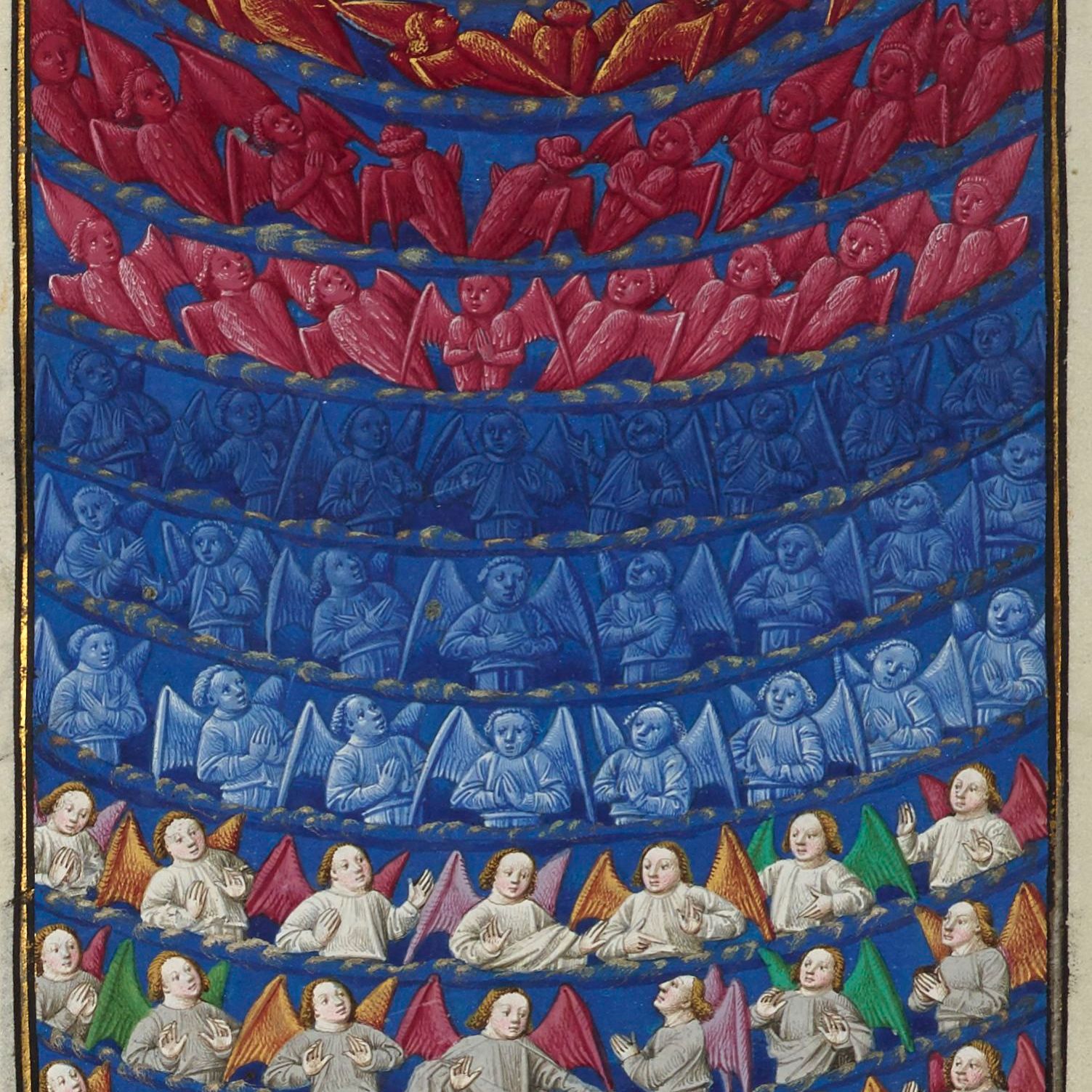



Similarly the highest ranked clerics of the Church wore red gowns. They still do. I’m talking about the cardinals of the Catholic Church, of course, that even have a shade of red, a red bird (the northern cardinal) and fishes displaying red scales (the cardinal tetra) named after them. According to Catholic theology, the Church on earth is supposed to reflect the heavenly Church of God and his angels. The pope equates God in this parallel and the cardinals equate the seraphs. Anyone who’d consider the Church not worthy of this holy comparison—because the earthly Church, reportedly founded by Christ himself, is supposed to be holy by definition—put himself in great danger. Such was the case of John Wycliffe, an English theologian who was personally protected by the King and therefore avoided ecclesiastical prosecution. Wycliffe wrote that the Church on earth couldn’t compare in terms of holiness with the heavenly Church of God. It gave birth to the long-lasting heresy of the Lollards, which would be persecuted and repressed violently.
As Michel Pastoureau reminds us, in his short and delightful book I’ve already referenced above, red was also the color worn by women on their wedding day, especially by brides from the lower social class.
The point I’m trying to make is that red was seen as a holy and prestigious color in the Middle Ages. As Michel Pastoureau reminds us, in his short and delightful book I’ve already referenced above, red was also the color worn by women on their wedding day, especially by brides from the lower social class.
I’ve done a quick research on that in digitized manuscripts and sure thing, we don’t see a single bride in white! White—as it is commonly known—became the traditional color of wedding gowns during the 19th century. Women were invited to wear their most expensive and lavish dress on their wedding day during the Middle Ages and red pigments were particularly expensive, beyond the fact that the color red carried a highly spiritual meaning. As for jewels, women often borrowed from their relatives on their big day but mostly they wore crowns. I’ve seen a few examples of golden and blue dresses—in one case I spotted a green dress. However, if the bride is not wearing any red herself, the groom or the witnesses would wear it instead. Red was the color of weddings!









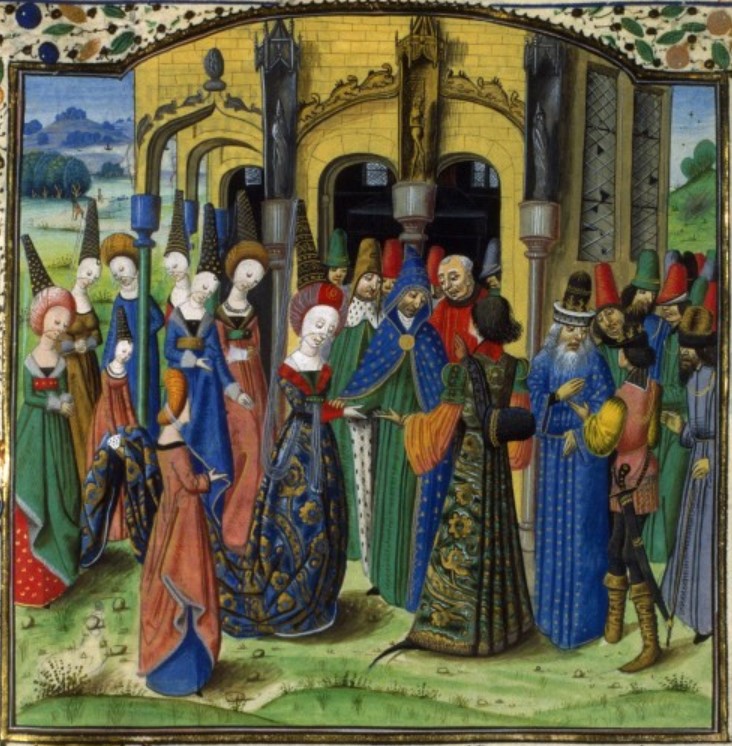
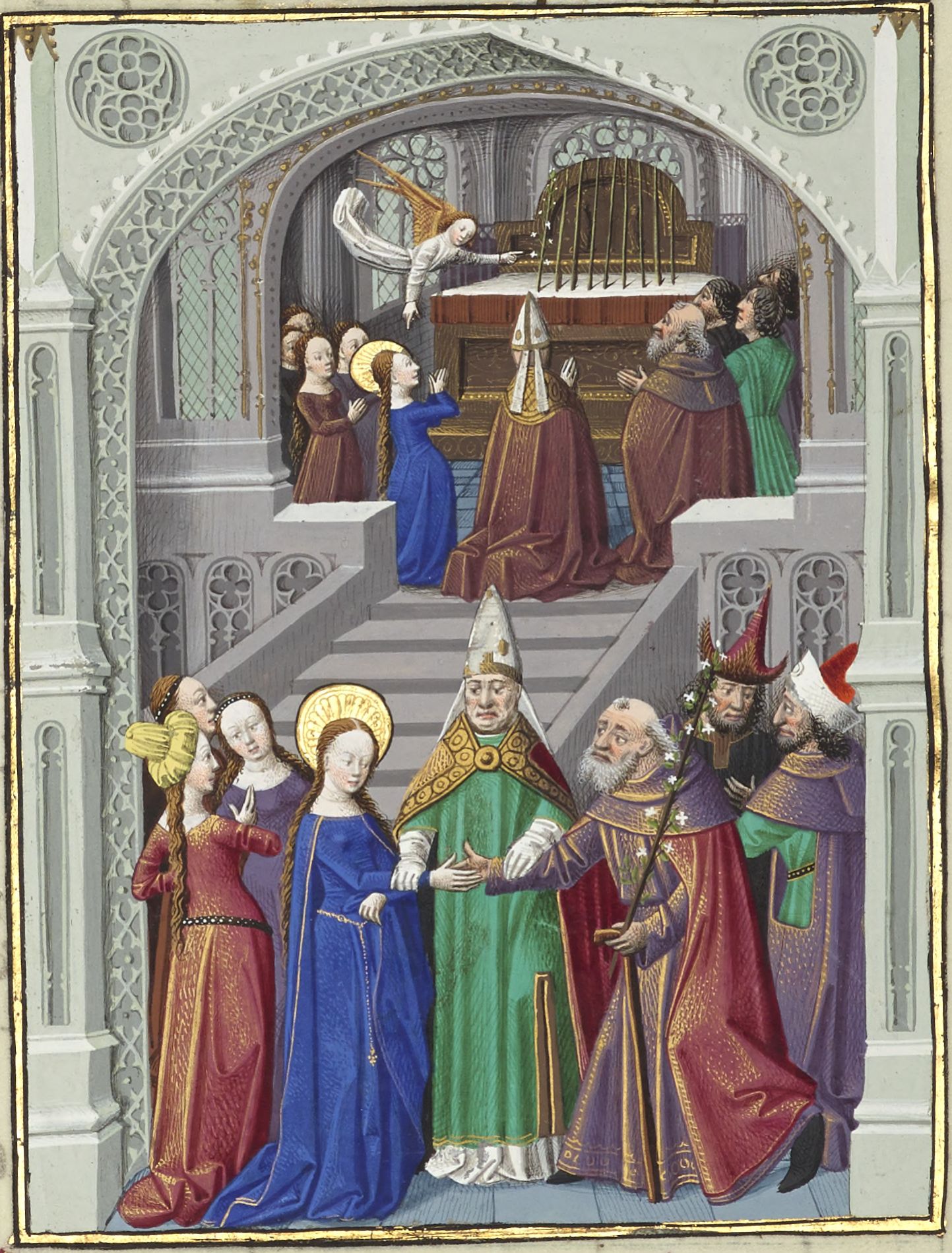

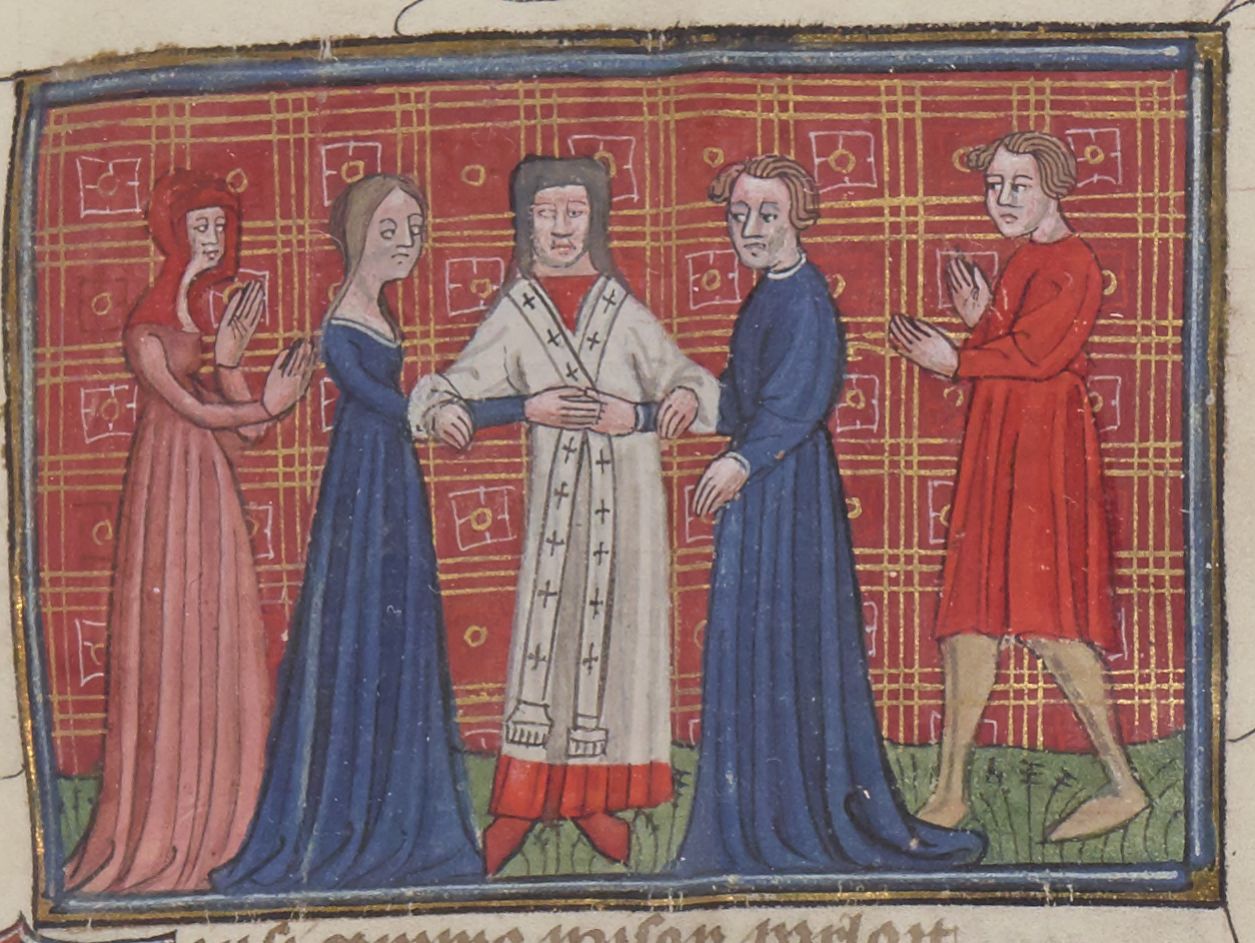

Red was the color of weddings!
Which brings us, naturally, to the infamous “Red Wedding” written by G.R.R. Martin in his novel series A Song of Fire and Ice—adapted for television in Game of Thrones. I will only mention it to stress how that wedding didn’t fit any properly medieval setting. Rarely do we read about weddings ending ugly in medieval chronicles. A wedding was a sacred ceremony, not only a feast but a holy moment well defined and framed by the Church. Any crime committed during a wedding would have resulted in the most pernicious and vicious excommunication. Carrying on sieges and battles on holy days were already the mainsprings of bad reputation to knights and military commanders. Joan of Arc suffered such a fate when she led the siege of Paris on a day devoted to the Virgin Mary. Straight out murders and massacres on wedding days would have caused the utter destruction of anyone’s reputation and it would have cost him all his allies. This was not a smart move. It is funny how sometimes G.R.R. Martin properly draws from medieval history, like when he writes about the death of Robert Baratheon during a wild boar hunting party, yet more often than not he stretches away from historical veracity to come up with his own symbolism. The Red Wedding is red because of all the blood that was shed. Weddings were red in the Middle Ages because most people dressed in red on such occasions and the color red carried a noble spiritual meaning.
The Red Wedding (in A Song of Fire and Ice) is red because of all the blood that was shed. Weddings were red in the Middle Ages because most people dressed in red on such occasions and the color red carried a noble spiritual meaning.
Red Beasts and Black Beasts
Red was the color of the divine, a color that carried prestige and meant power. If the Good, the Bad and the Ugly were medieval colors, the Good would be red, the Bad would be black, and the Ugly would be another tale entirely—though he could also be black. Such a definition helps us understand how animals were categorized in the Books of King Modus and Queen Ratio. The author, presumably Henry of Ferrières, divides commonly hunted forest animals into two sorts: the red beasts (the noble ones) and the black beasts (the nasty ones).
The five red beasts are the following: the deer, the doe, the fallow deer, the roe and the hare. The five black beasts are as follows: the boar, the sow, the wolf, the fox and the otter. One could argue that the fox is a red beast but the terminology here carries meaning beyond the sole color of the animal’s fur. The Books of King Modus and Queen Ratio is not only a hunting treatise, it is also an allegorical tale. Every time King Modus explains how animals are to be hunted, Queen Ratio delivers the symbolic and spiritual meaning of those animals according to the Christian faith and the Catholic dogma. That’s why she argues that if the deer has ten pikes on his antlers to defend himself from harm, the Christian has the Ten Commandments at his disposal to shield himself against all evil. The deer not only belongs to the “good beasts”, it is a Christological beast, whereas the boar is an evil animal that guards the satanic tree of the Devil’s Ten Commandments. It all belongs to the rhetoric that our world is merely the projected shadow of a higher one: God’s own realm.





What’s funny though is that in most manuscripts containing the Books of King Modus and Queen Ratio I found out that the boar was represented upon a red background (see above). So there may be more to red that I let on is this blog post. Indeed, as you can also see in the few illuminations depicting St John that I’ve encountered, the devil taunting him as he writes the Book of Revelation is not systematically black, he can also be red! Oh, the flimsiness of cultural and representation studies. What’s funny with the Late Middle Age allegoric literature is that anything could be seen as godly or devilish depending on the author’s intent as long as it respected or reminded the Catholic dogma in any way, shape or form. Even the fornication tales of Jupiter could carry a divine meaning to the more daring of medieval scholars. They wrote several books around that theme—but as Maz Kanata puts it in The Force Awakens: “That’s a story of another time.”


Going Full Circle: Black Beasts as the Beast
Boars, sows, wolves, foxes and otters were all considered as pests to get rid of. They were deemed dangerous. It was indeed a risky venture to hunt the wild boar in the forest, as many romances told and several dead kings proved to be true. Age of Empires 2 players must also be very careful when hunting the wild boars in the Dark Age.
Such beasts, the black beasts, were thought to stink, to bite, to destroy everything in their path. It comes as no surprise then that the Beast, the incarnation of evil, would adopt their features and characteristic. The Beast had to be black. And since it was formerly an angel, it had wings! But not any wings: bat wings.

Bats didn’t have the best reputation during the Middle Ages depending on where they lived. In Northern Spain? They were loved—but more on that in a minute. In Northern France? Not so much. To begin with, bats hairless, which is the reason why they’re called “bald mouse” in French (“chauve-souris”), and it gave way to several interpretations. Not all of them favorable to their kin. Bats are naked as the alcoholics and the gluttons are naked from selling even their clothes in order to give way to their addiction. That’s how the Ovide moralisé puts it*.
Moreover, the Latin word for bat is “vespertilio” (in Old French it was still “vespertille”). It meant “the bird that flies at night” or the bird of darkness. Bats are pleased to live in the dark and they wouldn’t have it any other way. They flee the light. Such are the sinners, who run away from knowledge and the holy beacon of faith and truth that was the Church (supposedly).
The Beast, who’s dark and black and master of evil, only has bat wings as a natural conclusion of the medieval symbolism I presented here to you. It answers the question why the devil was black in medieval manuscripts instead of red but it does not end this blog post. Here comes the bonus section for those who stuck until the end!
The Devil may have turned red, sure, yet he still appears in black today but in disguise, with another name and under another mantle. At night, he roams the streets of a major city that is infested by criminals. He tracks them down and give them Hell. You know that new devil yourself. His name is known to you. Batman, he is called. How did he acquire such a name? The legend says that Bruce Wayne was pondering at night how to inflict fear to criminals. In his office, he gathered his thoughts.
“Criminals are a superstitious cowardly lot, so my disguise must be able to strike terror into their hearts. I must be a creature of the night, black terrible… a… a…”
As if in answer, a huge bat flied in the open window.
“A bat! That’s it! It’s an omen..; I shall become a bat!”
And thus is born in this weird figure of the dark… this avenger of evil: the Batman.
~ DC #33, Nov. 1939
However, Bruce Wayne was certainly not the first person to have a bat fly in and become an omen. Oh, no! Such a fate happened to King James I of Aragon in the 13th century. Remember when I told you that bats had a good reputation in Northern Spain? Here is why**.
King James was in his tent, just as Bruce Wayne was in his office. King James pondered about the upcoming battle, just as Bruce Wayne pondered about his upcoming crusade against criminals. The word crusade is almost too fitting here since King James was readying himself against Moorish enemies. As he spotted the bat, he figured it was a good omen—just as Bruce Wayne did—and he put the symbol of a bat on the top of his banners the next day. The battle was won and since then bats have been figures of good luck in the region of Valencia and Barcelona, even to this day!
I started mentioning a football/soccer team. It is only fitting that I’d end up with another: the Valencia C.F. which celebrated its hundred-year anniversary this very year! If you look at their jersey, you’d see a bat on the top of their flag. As a matter of fact, it clearly reminds Iberian medieval coat of arms, where bats were not uncommon but very much present (I’ll let you look it up for yourselves).
Oh, the flimsiness of cultural and representation studies!
On a final word, I leave you to reconsider the hypothesis advanced by Gabriel Iglesias aka Fluffy. Could Batman be Mexican? King James spoke a kind of Spanish. Therefore Batman might very well be hispanic! Enjoy the video.
* More on that: Angela Calenda, “La métamorphose des Minéides en chauves-souris dans l’Ovide moralisé”, in Reinardus. Yearbook of the International Reynard Society, 28 (2016), p. 23-30.
** More on that: Denise Tupinier, “Origine et signification de la Chauve-Souris dans les provinces du Levant espagnol”, in Publications de la Société Linnéenne de Lyon, 54-2 (1985), p. 52-56.
